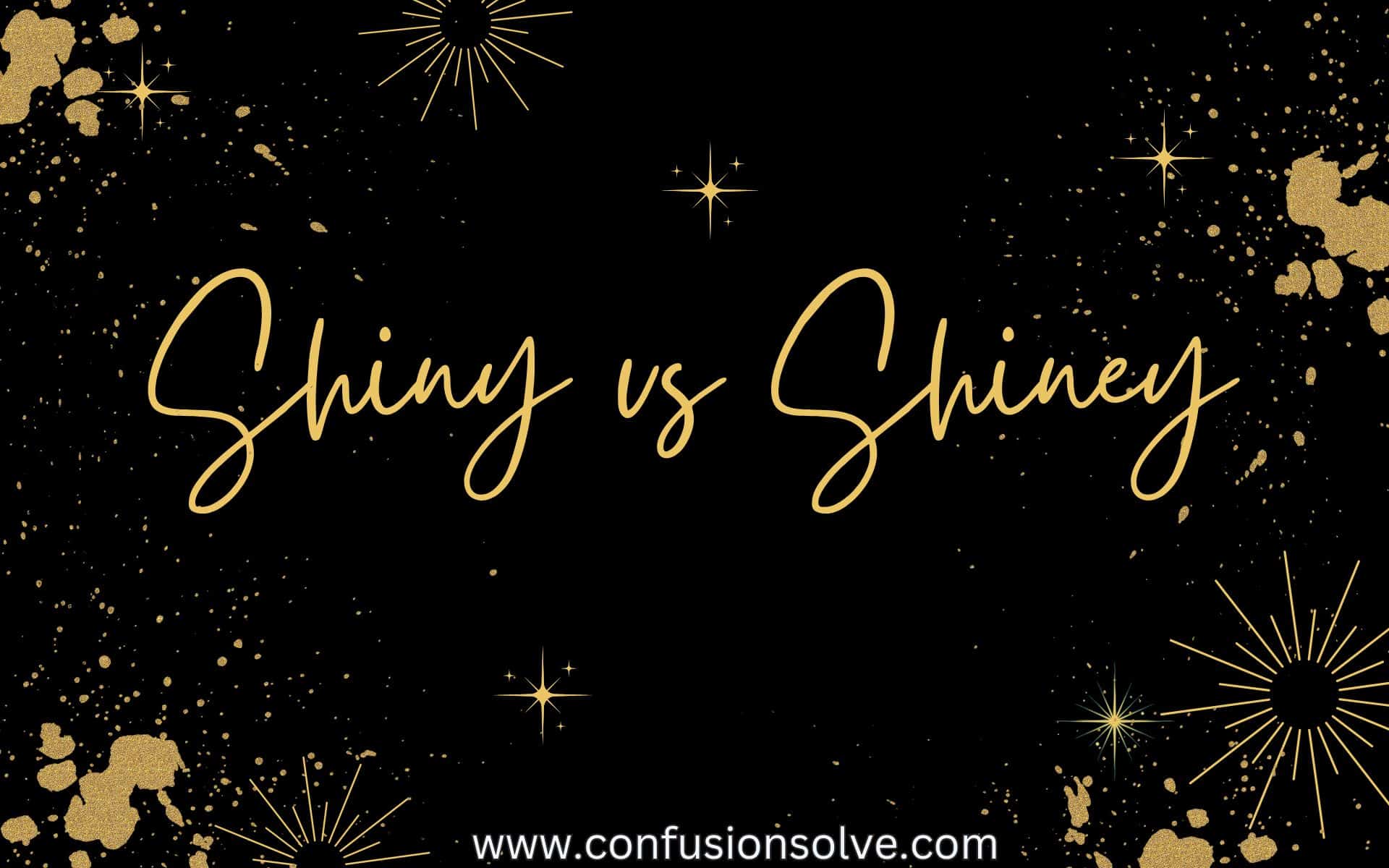Have you ever polished your car or admired a glossy pair of shoes and wondered, “Is it shiny or shiney?” You’re not alone! This tiny spelling dilemma trips up even the most careful writers.
The truth is, only one of these words is correct, and using the wrong one can make your writing look less polished than that sparkling surface you’re describing.
In this article, we’ll clear up the confusion once and for all, diving into the correct spelling of shiny, why people often misspell it as shiney, and how to use it like a pro.
Whether you’re writing an email, a report, or a social media post, knowing the difference will make your words shine brighter than ever!
Shiney or Shiny Spelling? Which One is Correct?
The correct spelling is shiny. This word describes something that reflects light or has a glossy appearance. For example, you might say, “The shiny car sparkled in the sun.” On the other hand, shiney is a common misspelling. It’s not recognized in any dictionary and should be avoided in both casual and professional writing.
Why does this confusion happen? Many people assume shiney is correct because the verb “shine” ends with an “e.” However, when forming the adjective, the “e” is dropped, and “-y” is added. This follows standard English grammar rules, making shiny the only correct form.
Key Takeaways
Here’s what you need to remember: shiny is the only correct spelling. It’s an adjective used to describe something glossy, bright, or reflective. Shiney is a misspelling and should never be used. Proper spelling is essential for clear and professional communication. Whether you’re writing an email, a report, or a social media post, always use shiny.
Shiney or Shiny: Defining the Key Difference
The key difference is simple: shiny is correct, and shiney is not. Shiny is an adjective that means something reflects light or has a polished appearance. For example, “Her shiny hair caught everyone’s attention.” In contrast, shiney is a misspelling that has no place in proper English. It’s often used mistakenly because of its similarity to words like “rainy” or “cloudy.”
Reasons for the “Shiny” and “Shiney” Confusion
People often confuse shiny and shiney for several reasons. First, the verb “shine” ends with an “e,” so it’s easy to assume the adjective should too. Second, words like “rainy” and “cloudy” end with “-ey,” which adds to the confusion. Third, when spoken quickly, shiny and shiney can sound almost identical. Finally, informal writing and social media often propagate the misspelling, making it seem acceptable.
Shiny Correct Spelling
Spelling accuracy is the foundation of effective communication. Whether you’re writing an email, a report, or a novel, correct spelling ensures your message is clear, professional, and credible. Shiny Correct Spelling refers to the polished, error-free state of your written work, achieved through attention to detail and the use of effective tools and strategies.
Why Correct Spelling Matters
- Clarity: Misspelled words can confuse readers or alter the meaning of a sentence.
- Professionalism: Errors in spelling can harm your credibility and leave a negative impression.
- SEO Benefits: In digital writing, correct spelling enhances search engine visibility by aligning with commonly searched terms.
- Engagement: Clear and polished text keeps readers focused on the content rather than errors.
Shiney Incorrect Spelling
Shiney is not a valid word in English. It’s a common misspelling that often appears in informal writing. However, it’s not recognized by any reputable dictionary. Using shiney instead of shiny can make your writing look unprofessional and confuse your readers.
Shiny – The Meaning
Shiny is an adjective that describes something glossy, bright, or reflective. It’s often used to describe objects like shiny shoes, shiny surfaces, or shiny hair. For example, “The shiny floor reflected the light beautifully.” The word can also be used metaphorically, such as “a shiny future full of possibilities.”
Shiney or Shiny? Examples from the Literature and Press
In literature and media, shiny is often used to create vivid imagery. For example, in F. Scott Fitzgerald’s The Great Gatsby, the author describes Gatsby’s car as “shiny and luxurious.” Similarly, in news articles, you might read phrases like “the shiny new smartphone attracted crowds.” These examples show how shiny is used to emphasize brightness and appeal.
What Does “Shiny” Mean in English?
The word shiny in English typically refers to something that reflects light or has a bright, polished appearance. Its meaning can vary based on context, encompassing both literal and figurative interpretations.
Literal Meaning of “Shiny”
In a literal sense, shiny describes objects or surfaces that are smooth and reflective. For example:
- Surfaces: A polished car, clean glass, or metal jewelry can all be described as shiny.
- Example: “The newly waxed floors were so shiny you could see your reflection.”
- Natural Elements: The sun, stars, or water glistening in the light can also be called shiny.
- Example: “The shiny dew on the grass sparkled in the morning light.”
Figurative Meaning of “Shiny”
Metaphorically, shiny can describe things that stand out, seem impressive, or appear new and exciting. Examples include:
- Newness or Appeal: Something fresh and desirable, often emphasizing its superficial allure.
- Example: “She bought a shiny new phone, even though her old one worked perfectly fine.”
- Attention-Grabbing: Used to describe things that captivate or distract because of their dazzling appearance.
- Example: “He’s always chasing shiny ideas without finishing what he starts.”
Colloquial and Cultural Uses
In slang or idiomatic expressions, shiny might have additional meanings:
- Flawless or Perfect: Sometimes used in a positive, informal way to indicate something is great.
- Example: “Everything is shiny in the new system update.”
- Distraction: Referenced in the phrase shiny object syndrome, which implies being easily distracted by exciting but unimportant things.
- Example: “He suffers from shiny object syndrome, always jumping to the next big thing.”
Synonyms and Related Words
Depending on the context, synonyms for shiny include:
- Glossy
- Sparkling
- Radiant
- Gleaming
- Luminous
Shiny in Pop Culture
The term shiny has also made appearances in media and entertainment:
- Firefly (TV Show): In the sci-fi series Firefly, shiny is slang for “excellent” or “cool.”
- Music: Used in song lyrics to evoke imagery of light and brilliance, such as “Shiny Happy People” by R.E.M.
Why “Shiney” is Not a Valid Word
Shiney is not a valid word in English. It’s a misspelling that has no etymological or grammatical basis. While it might appear in informal writing, it’s not recognized by any dictionary. Always use shiny to ensure your writing is accurate and professional.
Common Spelling Mistakes: Shiny vs. Shiney
One of the most common spelling mistakes is writing shiney instead of shiny. This error often occurs because people assume the adjective should keep the “e” from the verb “shine.” However, the correct form drops the “e” and adds “-y.” To avoid this mistake, remember the rule: shiny has no “e.”
How to Use “Shiny” in a Sentence
Using shiny in a sentence is easy. Here are a few examples:
- “The shiny car reflected the sunlight.”
- “Her shiny hair looked healthy and vibrant.”
- “The floors were so shiny, they looked like mirrors.”
The Grammar Rules Behind “Shiny”
The word shiny illustrates a straightforward grammatical rule in English: to form an adjective from a verb ending in a silent “e,” you drop the “e” and add -y. This rule transforms verbs into descriptive words that convey a characteristic or quality.
You may also like:Momma or Mama: Which One is Correct? A Complete Guide
How It Works
- Start with the Base Verb: In this case, the verb shine means “to emit or reflect light.”
- Drop the Silent “E”: Removing the silent “e” creates the base shin-.
- Add the Suffix “-y”: Appending -y forms the adjective shiny, which describes something that reflects light or has a polished, bright appearance.
Other Examples of the Rule
This pattern is common in English and applies to many verbs:
- Dust → Dusty: Describes something covered with dust.
- Mess → Messy: Describes something untidy or disorganized.
- Ice → Icy: Describes something cold and slippery, like ice.
These adjectives convey a state or characteristic related to the action or quality of the original verb.
Why This Rule Works
The addition of -y simplifies pronunciation and adheres to English phonetic conventions. Retaining the silent “e” would make the word awkward or difficult to pronounce (e.g., shiney).
Exceptions and Notes
While this rule is reliable, some exceptions exist:
- Verbs that don’t end in “e” follow a different pattern (run → runny).
- In some cases, adding -y changes the spelling slightly (fun → funny).
Additionally, this rule doesn’t apply to all verb-to-adjective transformations, as some require entirely different suffixes or forms (create → creative).
Why Do People Confuse “Shiny” and “Shiney”?
People often confuse shiny and shiney because of similar words like “rainy” and “cloudy,” which end with “-ey.” Additionally, the verb “shine” ends with an “e,” leading some to assume the adjective should too. Mispronunciation also plays a role, as shiny and shiney can sound alike when spoken quickly.
The Etymology of the Word “Shiny”
The word shiny comes from the Old English word “scīnan,” which means “to shine.” Over time, it evolved into the modern adjective shiny, meaning glossy or reflective. This evolution follows standard patterns in the English language.
Examples of “Shiny” in Everyday Language
Here are some examples of shiny in everyday language:
- “The shiny floor was slippery after cleaning.”
- “He bought a shiny new phone.”
- “Her shiny necklace caught everyone’s attention.”
How to Avoid Spelling Errors with “Shiny”
To avoid spelling errors, remember the rule: drop the “e” from “shine” and add “-y.” You can also use spell-check tools or practice writing sentences with shiny. For example, “The shiny surface reflected the light perfectly.”
You may also like:Forrest or Forest – What’s the Difference?
The Role of Silent “E” in Word Formation
In English, silent “e” is often dropped before adding vowel suffixes. For example, “shine” becomes shiny, and “hope” becomes “hoping.” This rule helps maintain consistency in word formation.
Synonyms for “Shiny” and Their Meanings
Here are some synonyms for shiny:
- Glossy: Smooth and shiny.
- Lustrous: Softly shiny.
- Gleaming: Bright and shiny.
- Polished: Made shiny by rubbing.
The Importance of Correct Spelling in Professional Writing
Correct spelling is a cornerstone of effective professional communication. It ensures clarity, builds credibility, and reflects attention to detail. In any professional setting, from emails to reports, flawless spelling is essential for maintaining a positive impression and avoiding costly misunderstandings.
1. Enhances Clarity
Misspelled words can confuse readers or alter the intended meaning of your message. For example, mixing up complement and compliment can lead to misunderstandings, especially in contexts where precision matters, such as legal or technical documents. Correct spelling ensures your ideas are communicated clearly and without ambiguity.
2. Builds Credibility
Spelling errors can undermine your authority and professionalism. In competitive industries, even minor mistakes can lead clients or colleagues to question your attention to detail. A well-written, error-free document demonstrates competence and fosters trust in your abilities.
3. Reflects Attention to Detail
Professional writing represents your personal or organizational brand. Spelling mistakes suggest carelessness and lack of effort, which may tarnish your reputation. On the other hand, polished writing signals thoroughness and a commitment to excellence.
4. Improves Communication Efficiency
Misspellings can lead to unnecessary back-and-forths to clarify intentions, wasting time and causing frustration. For instance, a typo in a client’s name or a product description might require corrections and apologies, slowing down the workflow.
5. Supports Search Engine Optimization (SEO)
In digital communication, correct spelling improves online visibility. Search engines prioritize content that matches user queries, and misspelled keywords may reduce your reach. Accurate spelling ensures your content aligns with search intent and reaches the intended audience.
You may also like:Onsite or On-Site: Which One Should You Use?
Tips for Maintaining Correct Spelling
- Use Proofreading Tools: Software like Grammarly and Microsoft Word helps identify and correct errors.
- Review Your Work: Manually proofread your writing to catch nuances automated tools might miss.
- Learn Common Mistakes: Familiarize yourself with frequently misspelled words like necessary, accommodate, and definitely.
- Seek Feedback: Ask a colleague or peer to review your work for additional scrutiny.
How to Remember the Correct Spelling of “Shiny”
To remember the correct spelling, think of the phrase: “Shiny has no ‘e’ – just like its smooth surface.” This mnemonic can help you avoid the common mistake of adding an “e.”
The Difference Between “Shiny” and Similar Adjectives
The Difference Between “Shiny” and Similar Adjectives
The word shiny often describes something that reflects light or has a polished appearance. However, similar adjectives like glossy, lustrous, and gleaming convey subtle distinctions in meaning and usage. Understanding these nuances helps you choose the right word to describe specific qualities.
You may also like:Roll Call vs. Role Call: A Clear Guide to Correct Usage
1. Shiny
- Definition: Reflective or bright due to light reflection.
- Usage: Typically used to describe objects that sparkle, reflect, or have a polished surface.
- Example: “The shiny car glistened under the sunlight.”
- Tone: General and versatile, often implying newness or cleanliness.
2. Glossy
- Definition: Smooth and shiny, often with a slick or polished surface.
- Usage: Commonly used for surfaces like photographs, paper, or hair.
- Example: “The magazine had glossy pages filled with vibrant images.”
- Tone: Suggests sophistication or refinement, especially in physical textures.
3. Lustrous
- Definition: Soft, radiant, and elegant shine.
- Usage: Often describes hair, fabrics, or other surfaces with a natural glow.
- Example: “Her lustrous hair caught the light beautifully.”
- Tone: Evokes a sense of luxury, richness, and beauty.
4. Gleaming
- Definition: Bright and clean with a steady or sharp shine.
- Usage: Frequently used for polished metal, glass, or clean objects.
- Example: “The knight’s armor was gleaming after being polished.”
- Tone: Implies something freshly cleaned, sharp, or impressive.
Key Differences at a Glance
| Adjective | Focus | Common Contexts | Connotation |
| Shiny | Reflective or bright | General objects, surfaces | Neutral to positive |
| Glossy | Smooth, polished shine | Photos, magazines, hair | Polished, sophisticated |
| Lustrous | Soft, radiant, and natural glow | Hair, fabric, gems | Luxurious, elegant |
| Gleaming | Bright, sharp, and clean | Metal, glass, polished items | Fresh, striking |
Choosing the Right Word
The choice depends on the context and the tone you want to convey:
- Use shiny for everyday descriptions of brightness or reflectivity.
- Opt for glossy when describing smooth, polished surfaces or textures.
- Choose lustrous for soft, rich, and elegant radiance.
- Pick gleaming for objects that are strikingly bright and clean.
Why “Shiny” is the Only Correct Form
Shiny is the only correct form because it follows standard English grammar rules. The misspelling shiney has no basis in the language and should always be avoided. By using shiny, you ensure your writing is accurate and professional.
Conclusion
In the end, the choice between shiny and shiney is clear: shiny is the only correct spelling. This simple adjective, meaning glossy or reflective, follows standard English grammar rules by dropping the “e” from “shine” and adding “-y.” On the other hand, shiney is a common misspelling that has no place in proper writing.
By using shiny correctly, you’ll ensure your writing is polished and professional. Whether you’re describing a sparkling car, gleaming hair, or a bright future, shiny is the word that will make your message shine. Remember, small details like this can make a big difference!
FAQs
- Is it spelled shiney or shiny?
The correct spelling is shiny. “Shiney” is a common misspelling. - Is it shiny or shiney slang?
“Shiny” is the standard term. “Shiney” is not slang—it’s simply incorrect. - What is shiney?
“Shiney” is an incorrect spelling of the word shiny and has no meaning in English. - What is the correct word for “shiny”?
The correct word is shiny, meaning glossy, bright, or reflective.










